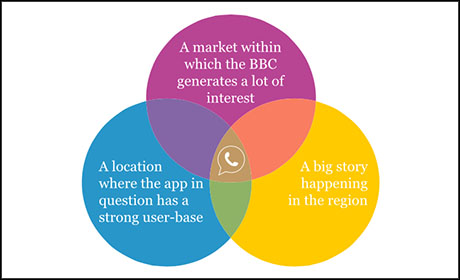
The Trends in Newsrooms 2015 report was launched at the World Editors Forum in Washington DC this week.
The report identifies nine trends in newsrooms around the world, summarised below.
1. Newsgames and VR
Spurred on by emerging wearable technology and more affordable virtual reality headsets such as Google Cardboard and Samsung Gear VR, games and virtual reality are changing the way news outlets are producing stories.
The BBC's interactive game Syrian Journey, launched earlier this year, was criticised by The Daily Mail and The Sun, with the latter quoting a 'Middle East expert' who accused the corporation of transforming "human suffering... into a children's game".
However, the report quotes Guardian games editor Keith Stuart as saying these criticism were born of "a misunderstanding about what gamers are – or can be".
Antoine Laurent, senior project manager at the European Journalism Centre – which funded the Rebuilding Haiti game – has said gaming elements are a way of combating "a lack of engagement and a lack of innovation on these topics, on development issues and developing countries”.
Other notable examples of gamification in journalism include #HungerProject by Rappler in the Philippines and Al Jazeera's interactive web-doc Pirate Fishing, which brought more than 80 per cent of first time users to the Al Jazeera website.

Screengrab from aljazeera.com/piratefishing
2. Source protection erosion
In the wake of "the Snowden effect", when journalists' data is more threatened by hacking and government surveillance than perhaps ever before, many journalists are "going back to basics" states the report.
In Algeria, Zine Cherfaoui, international editor of the newspaper El Watan, told the World Editors Forum that sources now increasingly require face-to-face meetings.
And former Guardian editor Alan Rusbridger, also quoted in the report, suggests it will become "very difficult" to do investigative journalism in the current climate of covert or overt surveillance in the UK.
However, in Sweden legislation to protect confidential sources is so strong that journalists can be jailed for revealing them.
3. Automation
Speaking at the World News Media Congress, AP's vice president and managing editor Lou Ferrara revealed how automating stories led to a ten-fold increase in the output of earnings reports.
The LA Times also used automating software to produce initial reports of a 3.2 magnitude earthquake struck in California in February 2013.
Those in support of automation claim it enables journalists to sidestep mundane or repetitive work to instead focus on stories where their time is more of value. Ferrera said it freed up staff time at AP by around 20 per cent.
On the other hand, critics such as Silicon Valley entrepreneur Martin Ford, author of Rise of the Robots, insists that automation is already replacing “good jobs” – including journalism.
4. Safety and eyewitness media post- Charlie Hebdo
The deadly attack on the Parisian office of satirical magazine Charlie Hebdo – and the ensuing siege at the Kosher supermarket – was a tragic reminder of the very real dangers faced by journalists in the pursuit of free speech.
“Safety has come in the mind of journalists everywhere since Charlie,” Monir Zaarour of the International Federation of Journalists told a UNESCO debate on the subject earlier this year.
The Charlie Hebdo attacks also raised important questions around the ethics and verification of eyewitness media during breaking news events.
Two bullets went through a door and windows writes @yvecresson at scene of #CharlieHebdo. Dunno whose bullets yet pic.twitter.com/iuH2QvJLQc
— Malachy Browne (@malachybrowne) January 7, 2015
5. The podcasting revolution
Although Serial is the most well-known podcast of recent years – reaching nearly 80 million downloads on iTunes – podcasting is a global trend, notes the report.
"From Copenhagen to Chicago, people are gathering in droves for communal audio storytelling events, held in theatres, churches, parks and ironically, cinemas, where foreign language audio is 'screened' with English subtitles," it states.
Pew's recent State of the News Media report also noted that 17 per cent of Americans said they had listened to a podcast within the last month, almost double the podcast listening percentage (9 per cent) from 2008.
6. Chat Apps Surge – riding the new wave of social media
The use of chats apps such as WhatsApp, WeChat and Line are gathering prominence as tools for distribution and engagement.
The BBC in particular has been using chat apps in its coverage for some time, most recently launching a 'lifeline' on Viber to assist survivors of April's earthquake in Nepal.
Many people in parts of the world where reliable internet access is relatively new have leapfrogged desktop connectivity altogether and gone straight to mobile.
The report states that in countries such as Malaysia, South Africa and Singapore more than 70 per cent of mobile internet users are on WhatsApp.
"And in countries where it doesn’t do so well," it continues, "like China, South Korea and Japan... it is usually because another chat app – WeChat, Kakao Talk, or Line – beat them to it."

The three criteria used by BBC’s mobile editor Trushar Barot to determine when chat apps can be used effectively (credit: Jason Evans)
7. The evolution of analytics
The way in which data and analytics are being used to guide newsrooms has "evolved significantly during the past year," states the report.
It cites the Guardian's Ophan in-house analytics platform as a good example of an outlet making newsroom metrics accessible and easy to understand for all staff.
The New York Times' director of analytics innovation James Robinson said metrics at the outlet are focused much more around engagement and attempting to understand readers, rather than volume.
8. The business of gender
An international study by the International Women’s Media Foundation (IWMF) found women make up only 36 per cent of reporters and a quarter of media decision-makers.
Bloomberg has one of the most effective strategies for tackling this gender inequality, states the report, introducing new policies, targets and goals to encourage more women into leadership positions within the organisation.
The report also flags the rise of a disturbing new threat to women in journalism: cybermisogony.
A 2014 study of Twitter abuse targeting celebrities by the think tank Demos found that journalism was the only category where women received more abuse than men – roughly three times as much as their male counterparts.
A recent Journalism.co.uk podcast investigated the problem of gender-based online abuse in journalism
9. Innovation in small newsrooms
From The Des Moines Register experimenting with virtual reality and 360˚ video to the news agency VietnamPlus using rap to engage younger audiences, size is no obstacle for smaller outlets to take on new and innovative projects.
Another highlight includes the Singapore-based Straits Times creating three community sites around entertainment, education and travel, whereby readers can see their stories and photographs published alongside ST’s professional journalists.
- The full Trends in Newsrooms report is available to purchase online, or free for Wan-Ifra members.
Free daily newsletter
If you like our news and feature articles, you can sign up to receive our free daily (Mon-Fri) email newsletter (mobile friendly).
Related articles
- How do news leaders define success in their newsroom?
- How Nature and TBIJ measure the impact of their journalism
- Overcome your metrics anxiety: how to develop a healthy relationship with audience data
- Elisabeth Gamperl of Süddeutsche Zeitung on metrics anxiety in the newsroom
- 'Conscious commissioning': what The Times learned from deep analysis of its journalism









